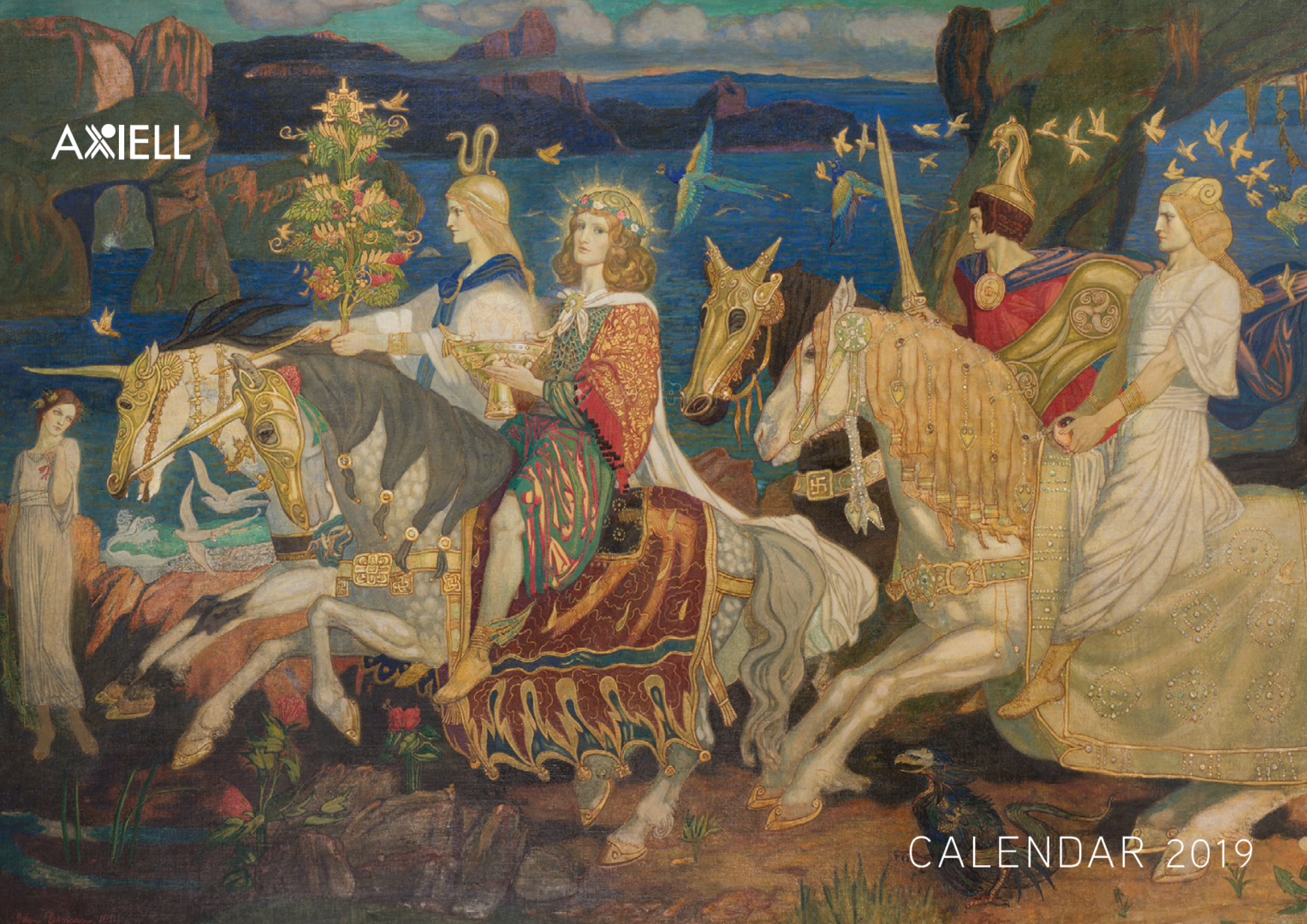Every year we ask our customers to submit something from their collection to go into a calendar which we distribute to customers, and every year we are treated to beautiful images and fascinating stories.
Here are the entrees we chose to go in the Axiell customer calendar for 2019:

The Riders of the Sidhe, John Duncan, 1911, Tempera on canvas
The McManus: Dundee’s Art Gallery and Museum, UK
This richly symbolic painting is arguably one of the most ambitious works of Dundonian John Duncan, a leading figure of the Celtic Revival Movement. In Celtic myth, the Sidhe are the fairy folk who ride forth each year on Midsummer Night.
One of Duncan’s masterpieces, this work is steeped in Celtic mythology. As the artist explains: “Each rider carries a symbol of age-long Celtic tradition. The Tree of Life means wisdom. The Love-Cup, the Grail cup of the heart of abundance and healing, is the symbol of Love. The Sword is the symbol of power or the will in action. The Stone of Quietness is the symbol of the will in its passive form, the crystal that reveals the past and the future.”
Duncan had an uncanny ability to recreate convincing Celtic and Medieval costumes, armour and other trappings. He used archaeological finds of Celtic artefacts for reference. The shield is loosely based on the Battersea Shield, the sword was likely inspired by a Bronze Age sword, the head gear reflects Iron Age helmets from Europe, and the horses’ head gear could be based on the Iron Age pony cap from Torrs.
Probably one of the best-known paintings in the collection of The McManus, this significant work is frequently requested by other institutions. Most recently it has been on loan to the British Museum for their exhibition Celts and has been included in the William Morris and the Arts and Crafts Movement in Britain touring show in Spain.
The collection is owned by Dundee City Council and is managed by Leisure and Culture Dundee. The work is on display at The McManus: Dundee’s Art Gallery and Museum in the Victoria Gallery. The McManus celebrated its 150th Birthday in 2017 and cares for over 150,000 objects ranging from Archaeology – Regional and Foreign, to World Cultures, Numismatics, Human History, the Natural Sciences, and Fine and Decorative Arts. The Whaling Collections, along with the Fine and Decorative Art Collections, are Recognised as Nationally Significant Collections by Museums Galleries Scotland on behalf of The Scottish Government.
Dundee City Council (Dundee’s Art Galleries and Museums)

Skeleton of Occitanosaurus Tournemirensis, Date of discovery: 1986
Musée de Millau et des Grands Causses, France
The 180 million year old skeleton of the Occitanosaurus tournemirensis, a 4 metre long marine animal from the Upper Triassic to the late Cretaceous period. It had a spindle-shaped body with a short tail and swimming paddles, and a small head with a thin, long neck that
allowed it to fish.
When a teenager out fossil hunting in southern France in 1986 came across the skeleton of a large marine reptile lying among dark clay deposits, he uncovered something quite unique. Not only was this perhaps the most complete specimen of Elasmosaurus found outside of Britain and Germany, examination also showed that it belonged to a new genus, Occitanosaurus tournemirensis. The name refers to its place of discovery in Occitania, in the town of Tournemire (Aveyron).
The Elasmosaurus lived in seas all around the world, from the Upper Triassic to the late Cretaceous period. Like the dinosaurs, the Elasmosaurus disappeared 64 million years ago.
The excavation was led by Jacques Sciau, palaeontologist. It took nearly two months to clear the bones, take a record of their exact position and record observations to keep track of the excavation context. The cleaning and the consolidation of the bones lasted more than four months, including one to reconstitute the skull; a puzzle made up of a hundred pieces!
The Occitanosaurus tournemirensis is one of two masterpieces of the collection of palaeontology of the Musée de Millau et des Grands Causses. This collection includes c. 500 objects or sets; it was mainly constituted by Jacques Sciau, an eminent palaeontologist, who donated it to the museum in 1994.
The Musée de Millau et des Grands Causses invites visitors to roam across the city and the plateaus around it through the ages. It allows visitors to discover the history and the story, the arts and the crafts of the South Aveyron region of France. The rich and diverse collections cover palaeontology, prehistory, and antiquity, and in particular the Terra Sigillata collection, medieval and modern archaeologies, and all the techniques of the famous local leather and glove industries.
Credits: Elasmosaure de Tournemire, Os calcifié, Toarcien supérieur, -180 Ma, Découverte : William Laporte, 1986

Boyle’s Anaesthetic Machine, British Oxygen Company Limited, 1960
Anaesthesia Heritage Centre, UK
Boyle’s machine with triple rotameters and two vaporisers with plungers and bypass levers. This machine would have delivered the anaesthetic agents: nitrous oxide / oxygen / carbon dioxide / ether / chloroform.
Without the development of anaesthesia and pain relief, most operations conducted today would not be possible. The fascinating history of this speciality is not as well-known as other medical professions, and yet it is the largest of them all. It is important to be reminded of the advancements in this field which have allowed us to further patient safety and comfort.
This small Boyle’s machine was one of the most common and famous anaesthetic machines used in the 1950s and 60s. It is one that many anaesthetists will be familiar with, and it is simple and easy to use design made it very popular. This was a time when huge advancements in anaesthesia had been made, the speciality now had formal qualifications and training, and was recognised as an equal with other consultancies. This machine represents all of that progress and it stands for the progress the profession is still making to ensure every patient has a safe surgery.
The collection at the Anaesthesia Heritage Centre is part of the Association of Anaesthetists.
The Anaesthesia Heritage Centre contains the Association of Anaesthetists’ archives, the Anaesthesia Museum and a rare book collection and is open to everyone. The Heritage Centre is a unique resource for research into the history of anaesthesia.
Part of the collection at the Anaesthesia Heritage Centre, London

Oorlogschip, H.J. Hoving, 1995
Muzeeaquarium Delfzijl, Netherlands
Scale model of a Dutch warship from 1664, made by H.J. Hoving, head restorer at Rijksmuseum Amsterdam. The model was built according to the shipbuilding book Aleloude en Hedendaegsche Scheepsbouw en Bestier by Nicolaas Witsen from 1671. The scale is 1 – 100.
The model is of a type of ship which fell under the Admiralty of one of the most skilled admirals in history, Michiel de Ruyter. Born in Vlissingen in the Netherlands in 1607, he is one of the most famous heroes of Dutch history. He died in 1676.
In 1652, the first English-Dutch War broke out and Michiel de Ruyter was made an admiral of the Dutch fleet. He was highly skilled in battle at sea, having trained in the wind and the shallows of the Zeeland and Netherlands coast. Because of this, and because of his success in the colonies, de Ruyter achieved great fame. For the English population, he became the embodiment of the enemy and the English were determined to defeat him.
One of his best-known victories was the Raid on the Medway in 1667; de Ruyter sailed up the Thames and into the Medway, wreaking havoc and eventually towing away the flagship of the English fleet, HMS Royal Charles. This was one of the Royal Navy’s worst defeats.
De Ruyter visited Delfzijl only once, on 6 August 1665, in order to circumvent the English by sailing through Norwegian and Scottish waters. Shortly after this, on 14 August, he became Lieutenant Admiral of Holland and West Friesland, the commander of the Dutch fleet.
Muzeeaquarium Delfzijl features a unique combination of a natural history and a cultural-historical collection with an aquarium in which fish and other marine animals from the Wadden Sea and North Sea can be seen. The Muzee Aquarium was reopened in 2018 after intensive renovation and refurbishment; it is a contemporary and surprising museum for young and old.
Muzeeaquarium Delfzijl, Photo by Anton Tiktak

Col. Poole’s Pig Hill of Fame, John Baeder, 1995, Oil on canvas
Morris Museum of Art, USA
This painting depicts a hillside in East Ellijay, Georgia, covered with pig-shaped plywood signs inscribed with the names of customers who have visited the restaurant in the foreground, two connected buildings with a sign advertising Oscar Poole’s restaurant and its Georgia Bar-B-Q, Hill of Fame.
Born in South Bend, Indiana, in 1938, John Baeder is famous for his depictions of humble eateries—he is particularly known for his paintings of diners—and is among the most important photorealist artists of the twentieth and twenty-first centuries.
One of Baeder’s most unusual Southern-themed paintings, Col. Poole’s Pig Hill of Fame, celebrates the roadside barbecue restaurant owned and operated by “Colonel” Oscar Poole. Featured in the work, in addition to the restaurant itself, are the Pig-Moby-il (the decorated yellow station wagon in the right foreground) and the Pig Hill of Fame which overlooks the restaurant. The hill is covered with more than 3,000 multi-coloured plywood signs in the shape of a pig, each emblazoned with the name of a customer. Baeder substituted the names of friends, family, and public figures (especially musicians) whom he admires for the names of the customers who had actually sought this memorial for themselves.
Baeder’s fascination with American roadside culture is evident in his choice of subject matter and his painstaking depiction of it. Here he documents, as he has since the early 1970s, an important aspect of the American experience.
With the purchase in 1989 of 230 paintings from the collection of Dr. Robert Powell Coggins, a renowned collector of Southern art, William S. Morris III established the identity and direction for the museum that he had founded in Augusta, Georgia. The Morris now owns more than 5,000 paintings, works on paper, photographs, and sculptures dating from the late-eighteenth century to the present.
Opened to the public in 1992, the Morris Museum of Art is the oldest museum in the United States that is dedicated to the art and artists of the American South. The museum’s mission is to create and maintain a collection of art that serves as a visual correlative to the culture of the South and to interpret that collection in regional, national, and global contexts.
Morris Museum of Art, Augusta, Georgia, USA. Purchase made possible by the Passailaigue Acquisitions Fund

Book of Latin Words and Phrases, believed to have been created by King George III, 1746-1805
Royal Archives, UK
Pages from a series of essays held in the Royal Archives, written either by King George III or by his mentor, Lord Bute. The essays formed an important part of the Prince’s, and later young King’s education, and cover a wide range of subjects reflecting his many and varied interests. This image shows a page containing lists of Latin vocabulary and English translations, with sketches of faces and other doodles.
To the left, you will find a bill, dated 8 January 1874, issued by William Fraser (Optical and Mathematical Instrument maker) for a pedometer in a gilt case with a compass, with receipt of payment. This item comes from George IV’s Privy Purse accounts covering the years 1783 to 1830, which provide a meticulous record of the King’s purchases throughout his life.
These images are examples of the material published online as part of the Georgian Papers Programme.
The Royal Archives preserves the documentary and administrative heritage of the Monarchy and the Royal Household, and we support public access to these historic records for the benefit of The Queen and the Nation.
Supplied by Royal Archives © Her Majesty Queen Elizabeth II 2018

Heinkel ‘Bubble’ Car July, Heinkel Car factory, c. 1958
County Museum, Dundalk, Ireland
Red, three-wheeled Heinkel ‘bubble’ car manufactured in Dundalk in the late 1950s, with the door located at the front.
The Heinkel ‘bubble’ car was manufactured in Dundalk for a short period at the end of the 1950s, on the site of the old workshops of the Great Northern Railway which closed in 1958. After WWII, the German Heinkel company diversified its production into car manufacture, setting up a plant in Dundalk. Unfortunately, production moved to England where the bubble car was manufactured under the Trojan name. This car has universal appeal and is hugely popular with the visiting public, evoking memories amongst those who remember driving the car, with younger visitors laughing at the idea of a three-wheeled motor car.
The Heinkel ‘bubble’ car is part of the Museum’s extensive industrial collection which features engineering, linen production, brewing, distilling, tobacco production and agriculture.
Chronicling the historical development of County Louth from the Stone Age to the present, the County Museum, Dundalk is one of Ireland’s finest museums. With a twin focus on the area’s archaeological and industrial history, the museum has a wealth of artefacts, including examples of rock art, William of Orange’s jacket at the Battle of the Boyne and the first Olympic medal to be won by an Irishwoman, Beatrice Hill-Lowe, in the archery event at the 1908 London Games.
Image courtesy of County Museum, Dundalk

Viking Age Ring, Unknown, 8-9th century
The Swedish History Museum, Sweden
A ring discovered in a Viking grave in Birka, Sweden. It is made of silver alloy and contains a piece of glass with an inscription written in Kufic Arabic script, which says “For/ to Allah”. It is the only known Viking Age ring with an Arabic inscription to be found in Scandinavia.
The Viking Age ring is made of gilded silver and was found in a grave at Birka, a trading and merchant site on Björkö, some 30 kilometres west of present-day Stockholm. The grave is likely that of a wealthy woman as it contained jewellery, including two oval brooches.
We know from contemporary Arabic sources that such rings often were gifts from Muslim merchants to women. The objects from the Caliphate that came to Scandinavia through trade routes across eastern Europe, a continuation of the Silk Road, are among the most fascinating in The Swedish History Museum.
At the Museum there are many beads, scales, weights and thousands of silver coins, alongside beautiful goblets and fragments of silk fabric. These objects are our witness to the contact and to the important mutual influence between the early Islamic world and eastern Scandinavia through trade. Northern European traders travelled all the way to Bagdad and sometimes even to the area around the Caspian Sea.
The ring belongs to a collection of 100,000 Viking Age items from Birka.
The Swedish History Museum is one of the biggest museums in Sweden. Every year, hundreds of thousands of visitors come from Sweden and around the world to see one of the world’s largest Viking exhibits, Sweden’s foremost gold and silver treasures, incomparable medieval art and unique finds from one of the most violent battles of Swedish history – the Battle of Gotland, 1361.
The Swedish History Museum, Stockholm, Sweden.

Moving Day, Unknown, October 1887
Alleyn’s School, UK
Photograph of Alleyn’s School (formerly the Lower School of Alleyn’s College of God’s Gift at Dulwich) on the day they moved from the historic College in Dulwich Village in October 1887 to larger and more modern premises in Townley Road. These boys formed a pipe band which led a procession of 250 boys through Dulwich village from the old building to the new. Two photographs were taken on that day. The first as the boys left the old college building and the second when they arrived at their new premises.
This photograph was taken to commemorate a key date in the development of Edward Alleyn’s Foundation. The Foundation was made official on 13 September 1619 when Edward Alleyn received his Foundation Charter. Alleyn was an actor, businessman, theatre owner, philanthropist, Overseer of the King’s Bears for James I, and a contemporary of Shakespeare. He established the Foundation with money from his Manor of Dulwich and via Letters Patent from James I, to support the poor and elderly of Southwark via schools and almshouses. It has survived in various legal formats for the last 400 years and 2019 will mark a year of celebration and commemoration.
The original Foundation school divided into two in the 1880s with one branch developing into Dulwich College and the other into Alleyn’s School. Both schools will be celebrating the enduring legacy of their founder, Edward Alleyn, during 2019. Alleyn’s School is committed to developing its archive service as one small part of this anniversary year.
These photographs form part of the institutional archive of Alleyn’s School.
Alleyn’s School is one of the country’s leading HMC co-educational day schools, committed to achieving educational excellence within an ethos of strong pastoral care and a vibrant co-curriculum.
Alleyn’s School Archive

Ijsberen (Polar Bears), Adolph Friedlander, 1908
Special Collections University of Amsterdam, Netherlands
This 1908 circus poster was designed by Adolph Friedlander, a famous printer from Hamburg, Germany. It is a beautiful picture which juxtaposes summer and winter, and seems rather prescient under our current circumstances. It reminds us of the decline of the polar icecaps, while the polar bears seemingly reflect human apathy for their surroundings.
The same picture is also featured as a reproduction in the collection, from the famed touring circus of Wilhelm Hagenbeck. (Collection Jaap Best)
This poster is from the Herman Linssen Circuscollection, nowadays housed in the Theatre Collection of Special Collections of the University of Amsterdam. The theatre collection came into existence in 1925 when several private collections were brought together for benefit of the Tooneelmuseum. The collection now consists of all theatre disciplines, and includes tens of thousands of posters, photographs, theatre costumes, props, programs, paintings, prints, models, backdrops, audio and video recordings, and archives. Since 2013, the former Theater Instituut Collection has been part of the Special Collection of the University of Amsterdam, which is itself now part of the Allard Pierson.
From the Nile to the Amstel, the Allard Pierson Museum at the University of Amsterdam takes you on a journey through 10,000 years of cultural history. Start in fascinating Ancient Egypt and end in Amsterdam with its creative industries (17th – 21st centuries). From mummies to classical art and medieval treasures to modern graphic design.
Theatre collections of Special Collections University of Amsterdam

Inner View of Newcastle, Joseph LYCETT, c. 1818 (detail), Oil on canvas,
Newcastle Art Gallery, Australia
Inner view of Newcastle c. 1818 uncovers a colonial outpost in its infancy. Joseph Lycett was an artist, who also had a talent for forgery, for which he was transported to Sydney in 1814. In 1815 he was again convicted of forging bank notes while working as a clerk in the police office, and sent to Newcastle for harsher punishment. In 1817 he was commissioned by Captain James Wallis, Commandant of Newcastle, to document the growing settlement on the shores of Newcastle (then Coal River).
The painting can be described as a romantic construction at best, nationalistic propaganda at worst. It was created to convey to an audience in England a very ordered and genteel way of life in the colony (once described as Sydney’s Siberia by historian and author J.W. Turner, a place where convicts who had committed further crimes after their arrival in New South Wales were sent for secondary punishment).
Little is known of the rest of Lycett’s life. A pencilled note in the Mitchell Library, Sydney, states that when he was living near Bath, UK, he was again arrested for forgery. He then cut his throat and, when recovering in hospital, tore open the wound and died in 1828. But this is not confirmed.
Only four paintings by Lycett are known to exist; three belong to Newcastle Art Gallery. These paintings are the basis of a major exhibition The 1818 Project, which 200 years since Lycett painted key colonial landscapes, brings together contemporary artists to address personal cultural histories and stories of migration, colonisation, identity, lost histories and forgery.
Newcastle Art Gallery’s collection presents a comprehensive overview of Australian art from colonial to present times as well as key pieces of historical importance, a diverse range of Indigenous bark paintings and the nation’s finest collection of 20th century Japanese ceramics. The collection has grown to over 6,500 works of art since 1945 when Dr. Roland Pope bequeathed his collection of 123 works of art on the condition that an art gallery be constructed; this became Australia’s first purpose-built regional gallery.
Joseph LYCETT, Inner view of Newcastle c. 1818 (detail), Oil on canvas, 59.5 x 90.0 cm. Purchased with assistance from the National Art Collections Fund, London, UK 1961, Newcastle Art Gallery collection.

Dodo Claret Jug, Alexander Crichton, 1881-2
National Trust for Scotland, UK
This claret jug is the creation of the great Scottish designer and silversmith, Alexander Crichton. It was inspired by John Tenniel’s illustration for Lewis Carroll’s Alice’s Adventures in Wonderland (1865). Crichton was the maker of many whimsical animal claret jugs, including crocodiles, cockatoos and penguins. His skill and ingenuity as a designer have rarely been surpassed.
The jug was formerly part of the prestigious collection of William Douglas-Hamilton, 12th Duke of Hamilton. The Dukes of Hamilton had a claim to the Scottish throne and were the premier peers of Scotland. Their collection has been described as “Scotland’s Royal Collection” and was considered to be the greatest art collection in Scotland’s history.
Due to its historical importance and its popularity with the public, the Dodo has been chosen as the logo for the National Trust for Scotland’s £1.3m cataloguing and conservation initiative, Project Reveal. The project aims to enhance and update the collections management database records for the vast and diverse collections in the care of the Trust.
The Dodo claret jug represents not only the pinnacle of Scottish design and connoisseurship but the continuing drive for improved interpretation, accessibility and engagement with NTS collections, which is made possible through collections management systems.
The Dodo is now part of the prestigious collection at Brodick Castle, which also includes a large group of objects purchased by William Beckford. It is one of six wine ewers in the collection designed by Alexander Crichton. The object on the back is also from the collection at Brodick Castle. It is a sculpture of an Astrologer: one of a set of two silver mounted carved fruitwood figures, in the form of an astrologer holding a telescope in his right hand and an armillary sphere in his left. His clothes are overlaid with signs of the zodiac. Jan Bonket, 1772.
The National Trust for Scotland is a conservation charity supported by more than 380,000 members and funded largely by donations. By championing Scotland’s natural, built and cultural heritage we inspire those around us. We care for around 300,000 objects in over 50 properties, including one of the greatest collections of art in Scotland.
National Trust for Scotland, Brodick Castle




